| |
|
|
|
|
|
|
|
|
|
|
| |
| |
 |
|
| |
田润德
编译
文/图 2020-10-15 19:36 |
|
| |
|
|
|
|
| |
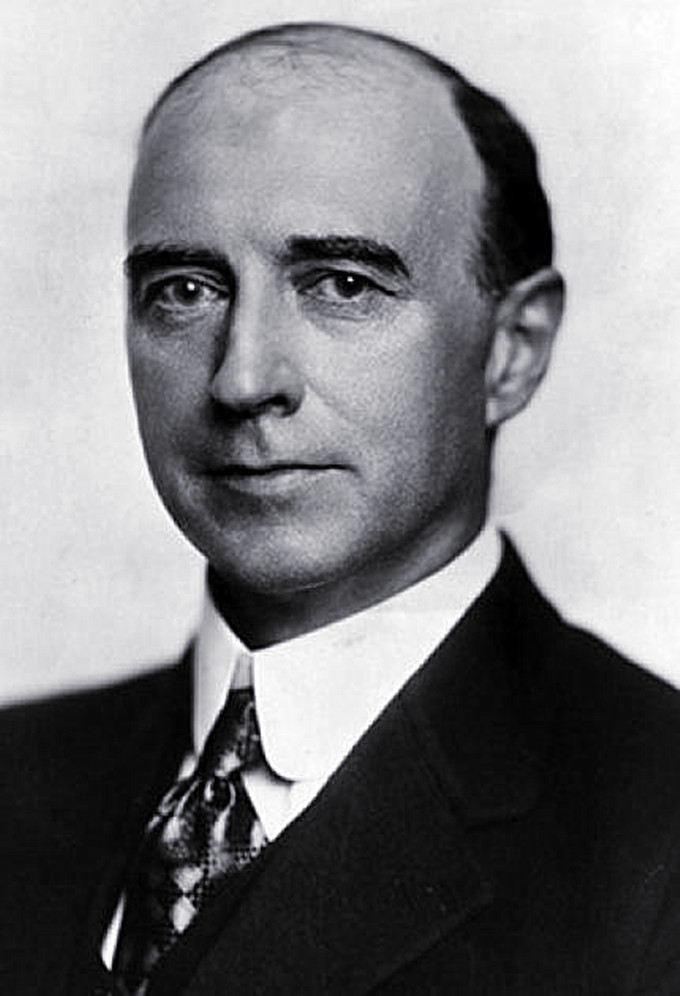 |
|
|
|
| |
华莱士.萨宾(Wallace
Sabine,1868——1919) |
|
|
|
| |
|
|
|
|
| |
波士顿交响音乐厅举办小泽征尔作为波士顿交响乐团音乐总监的最后一场音乐会。 |
|
|
|
| |
2002年4月20日,波士顿交响音乐厅举办小泽征尔作为波士顿交响乐团音乐总监的最后一场音乐会。
2002年4月,小泽一郎作为BSO的音乐总监,在交响音乐厅举办了他的最后一场音乐会。他担任BSO领导人的29年是其历史上最长的,甚至超过了谢尔盖·库塞维茨基的传奇任期。在辞去BSO的职务后,小泽一郎被任命为该乐团的桂冠音乐总监,这个头衔他至今还保留着。
随着小泽走上舞台,在这场告别演出中,强烈的情感是显而易见的。在和音乐家们打过招呼之后,他整理了一下自己,然后转向观众,在演出开始前,观众们起立鼓掌。小泽以记忆指挥而闻名,他的乐谱就放在乐谱架上,他的表演就像跳舞,他的动作优雅而富有表现力。在最后一曲中,时间似乎暂停了,这是交响乐曲目中一些最动人的音乐。
小泽与马勒的紧密联系在马勒的全部交响曲的BSO中得到了很好的记录。作为音乐总监,他选择《第九交响曲》作为自己的最后一场音乐会,部分原因是这部作品有一种著名的告别气氛。当马勒在1909年开始创作这部交响曲,并在1910年4月,也就是他50岁生日的前几个月完成时,他已经非常清楚自己的死亡。这是他完成的最后一件作品。虽然交响曲的开头和结尾似乎都在思考死亡以及死亡之后的世界,但第二和第三乐章却深入挖掘了生命的活力、幽默和甜蜜。
|
|
|
|
| |
|
|
|
|
| |
音乐历史上的今天
1900年10月15日,波士顿交响乐团搬进音响效果完美的交响乐厅,设计师是华莱士.萨宾(Wallace Sabine,1868——1919)。
萨宾(Sabine,Wallace Clement Ware)
美国物理学家。1868年6月13日生于俄亥俄州里奇伍德;1919年1月10日卒于马萨诸塞州坎布里奇。
萨宾于1886年毕业于俄亥俄国大学,后入哈佛大学攻读研究生。最后在哈佛任教并于1905年成为该校的物理学教授。
1895年,哈佛大学一座新大楼落成,楼中有一个很象样的教室,只是有一点“小”缺陷,那就是由于回声太大而听不清讲课。萨宾被请来解决这个问题,他不仅研究了声波的照片(这种声波照相术后来为D.C.密勒所发展)。萨宾根据自己的研究创建了建筑声学这门科学。自此之后,原来只靠碰运气的事情,变成了一件可通过预想和计算实现的了。第一座按照赛宾的原理进行设计的建筑物是1900年10月15日落成的波士顿音乐厅。此音乐厅被证明是一项巨大的成功。赛宾发现,他可以将声音在某间室内被吸收的情况,折合成房间内开了多大面积的窗子。因为从窗口传到室外的声音,就相当于帷幕之类吸收掉的声音。他将一个面积确定的窗口定为吸收性能的标准,把许多种物质造成的回声持续时间与此标准相比较,从而测定了这些物质的吸收性。他发现,回声的持续时间----即所谓混响时间----和房间的总吸收性的乘积是一常数,而且这个常数同房间的容积成比例。这就是萨宾定律,它已构成设计讲求音响效果的房间的建筑学基础(这样的房间应有足够的回声混响,以护持音响的响亮和丰满,但又不至多得令人难以听清声音)。
今日视频:1、波士顿交响音乐厅举办小泽征尔作为波士顿交响乐团音乐总监的最后一场音乐会;
2、《一切皆有可能》——波士顿男同性恋合唱团。(2017年6月4日在波顿响音乐厅现场录制。)
|
|
|
|
| |
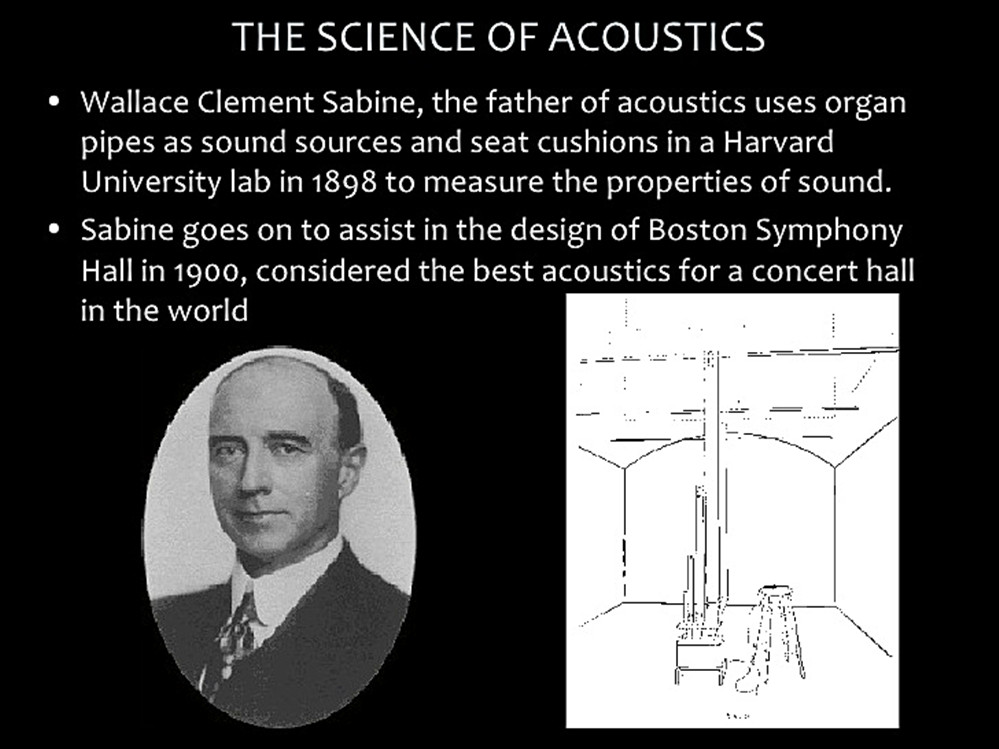 |
|
| |
华莱士.萨宾(Wallace
Sabine) |
|
|
|
| |
声学科学声学之父华莱士·克莱门特·萨宾于1898年在哈佛大学的实验室里使用管风琴作为声源和坐垫来测量声音的性质。1900年,萨宾协助设计了波士顿交响音乐厅,被认为是世界上音响效果最好的音乐厅
。 |
|
|
|
| |
 |
|
|
|
| |
华莱士·克莱门特·萨宾,物理学家,哈佛教授,建筑声学之父(照片:萨宾纪念馆) |
|
|
|
| |
华莱士·萨宾小传
萨宾是建筑声学的先驱。他定义了混响时间并根据经验推导出了它的公式,这帮助他预测和优化了大型礼堂的音响效果,比如哈佛大学的福克讲堂和波士顿的交响乐大厅。
年仅18岁从俄亥俄州立大学毕业后,萨宾进入哈佛大学进行研究生学习,并在那里的物理系担任年轻的助理教授。虽然他是一个很受欢迎的讲师,但是萨宾从来没有拿到他的博士学位——也许这就是为什么在1895年,他被分配了一项令人讨厌的任务——改善新近开放的福克艺术博物馆的演讲大厅的声学,这被认为是一项不可能完成的任务。尽管在声音方面没有特别的背景,萨宾现在开始了声学的研究。他试验了不同材料的吸收性能,他和他的团队在晚上在桑德斯剧院和福克讲堂之间移动,因为这两个房间在白天正常使用。萨宾用管风琴和秒表测量了他所定义的混响时间,即声音强度下降60分贝所需的时间。他发现了房间的大小、吸收表面和声学质量之间的关系,迅速在新兴的建筑声学领域扬名立万。1898年,建筑公司McKim,
Mead &
White向萨宾寻求规划波士顿交响音乐厅的建议。利用福克博物馆的实验材料,萨宾能够根据经验开发出预测声学特性的公式,从而为现在被认为是世界上最好的音乐厅之一的建造做出了贡献。1900年,他与内科医生简·唐斯·凯利(Jane
Downes Kelly)结婚,五年后,他被任命为哈佛大学(Harvard
University)物理学教授。在第一次世界大战期间,萨宾是国家航空咨询委员会的成员。1919年,他死于肾脏感染手术后的并发症,享年50岁。
萨宾从1894年起就是美国艺术与科学学院的成员。吸声单位——萨宾(一平方英尺100%吸声材料的价值相当于一个萨宾单位),以他的名字命名。 |
|
|
|
| |
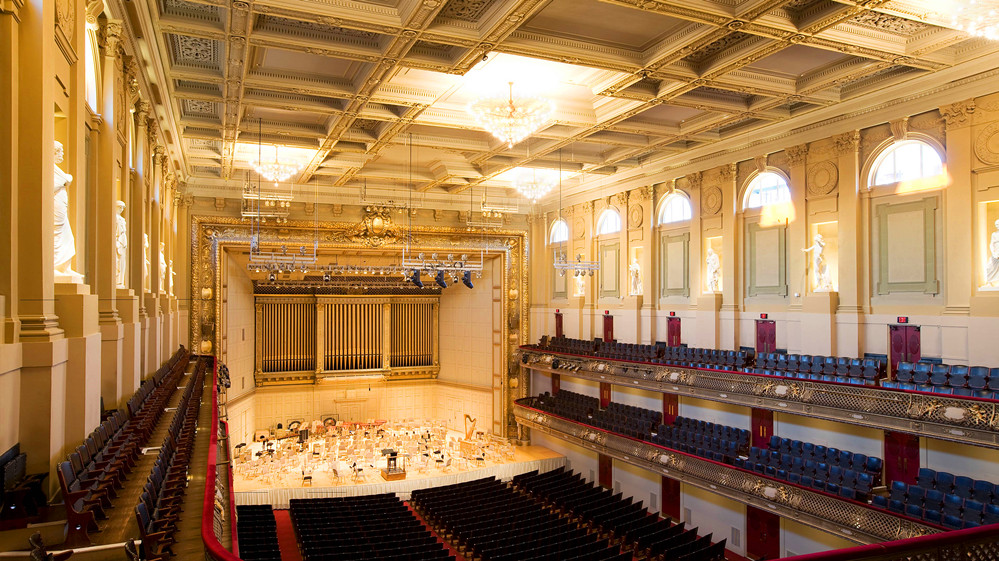 |
|
| |
声学科学声学之父华莱士·克莱门特·萨宾于1898年在哈佛大学的实验室里使用管风琴作为声源和坐垫来测量声音的性质。1900年,萨宾协助设计了波士顿交响音乐厅,被认为是世界上音响效果最好的音乐厅 |
|
|
|
| |
华莱士·萨宾接受记者采访: |
|
|
|
| |
什么物理参数构成了一个好的音乐场所?
为此,我们需要回到华莱士·克莱门特·萨宾(1868-1919)——可以说是建筑声学中最著名的名字。
萨宾甚至有一个测量单位以他的名字命名(萨宾公式或萨宾方程),在辛辛那提有一个大厅以他的名字命名。
最近在一个风雨交加的夜晚,我在降神会上遇到了华莱士·萨宾。
以下是我们关于回声时间的“虚拟”对话。
主持人:你好,萨宾教授。
我可以叫你华莱士吗?
萨宾教授: 不可以。
主持人:嗯,萨宾教授,我知道一个好的声音大厅有四个基本要素:
1)演奏者和听众都要有足够的音量;
2)早期第一声反射;
3)均匀分布的声音;
4)混响特性,适合所演奏的音乐类型。
萨宾教授:是的。
主持人:我知道最重要的是混响时间。
萨宾教授:是的。
主持人:从混响时间的研究中得出的一个结论是,早期反射(可能为80微秒)与较长时间反射的比值可以用来传达一些有关表演大厅质量的信息。
萨宾教授:是的。
主持人:嗯,这是相关的发现这个比例(称为C80)与清晰(时态定义)有高度的相关性,这比例高意味着好清晰直接的声音和反射到达早于80年初msec剩余的能量比80
msec晚到达吗?
萨宾教授:是的。
主持人:那么低的比例也意味着缺乏早期反射和过度混响?
长方形音乐厅之所以成功并经久不衰,原因之一是侧墙和天花板提供了强烈的早期反射,从而增强了清晰度。
萨宾教授:是的。
主持人:嗯…
让我们转到混响时间的另一个方面。
某些类型的音乐的音质是经过一定的混响时间优化的,这是真的吗?确实,这就是它们产生的原因吗?
例如,管风琴音乐有很多持续的音符在周围回响,最好在较大的场所听到,混响时间较长,如1.5-2.5秒。
又或者,风琴音乐广受喜爱是因为当时音乐厅的混响时间在1.5到2.5秒之间?
萨宾教授:是的。
司仪:我想我们今天并没有从你身上得到什么。
让我试试另一种方法。
我给你一种音乐类型,你告诉我每种类型的混响时间。
萨宾教授:是的。
主持人:太好了。
我们走吧!
歌剧。
萨宾教授: 1.3 - -1.6秒。
主持人:哇!
室内乐。
萨宾教授: 1.0 - -1.5秒。
主持人:音乐厅。
萨宾教授: 1.7 - -2.0秒。
主持人:浪漫的音乐。
萨宾教授: 2.0 - -2.3秒。
主持人:生活剧场。
萨宾教授: 1.0秒。
主持人:在会议室演讲。
萨宾教授: 0.4 - -0.9秒。
主持人:嗯,谢谢你提供的信息。
我认为在会议室(可能还有教室)进行最佳演讲的原因是反响越小越好,这样的假设对吗?
萨宾教授:是的。
主持人:天哪,我想我们又回到简短的答案了!
萨宾教授:一点也不!
在任何空间里,总是要在太活和太死之间找到平衡……如果你能原谅这个双关语的话!
混响时间为0.1秒会让房间听起来不新鲜、死气沉沉的,而在同一间房间里,如果混响时间为5秒,没有人能听懂任何东西。
你说得对,在历史上的大部分时间里,演奏的音乐都是当时建筑的直接反映。
我不认为管风琴音乐在今天的多功能厅里会像在过去的大型教堂里那样受到人们的欣赏。
但即使是回响时间也有其局限性。
例如,波士顿交响音乐厅、旧金山戴维斯音乐厅和伦敦巴比肯音乐厅的混响时间都差不多,约为1.7-1.85秒。
然而,前两个大厅的声音很好,而巴比肯大厅只有被评为公平到良好的音质。
主持人:我现在可以说话了吗?
你似乎想登上领奖台!
我想我们已经结束了,我将让你们回到你们所做的事情上。
再见!
嗯,我还没说完呢。
我想谈谈…
(这篇文章的部分内容是从Chasin博士的博客hearinghealthmatters.org上发表的两篇文章中编辑和改编的。
这篇文章的原始引用:Chasin M. Back to Basics: Wallace Sabine, Music Halls,
and混响时间。)
|
|
|
|
| |
 |
|
|
|
| |
建筑师用来在新建筑中创造良好声学的萨宾方程。 RT60是混响时间(下降60分贝),v是音量 |
|
|
|
| |
The Sabine Equation
which architects use to create good acoustics in new buildings.
RT60 is the reverberation time (to drop 60 dB) V is the volume
of the |
|
|
|
| |
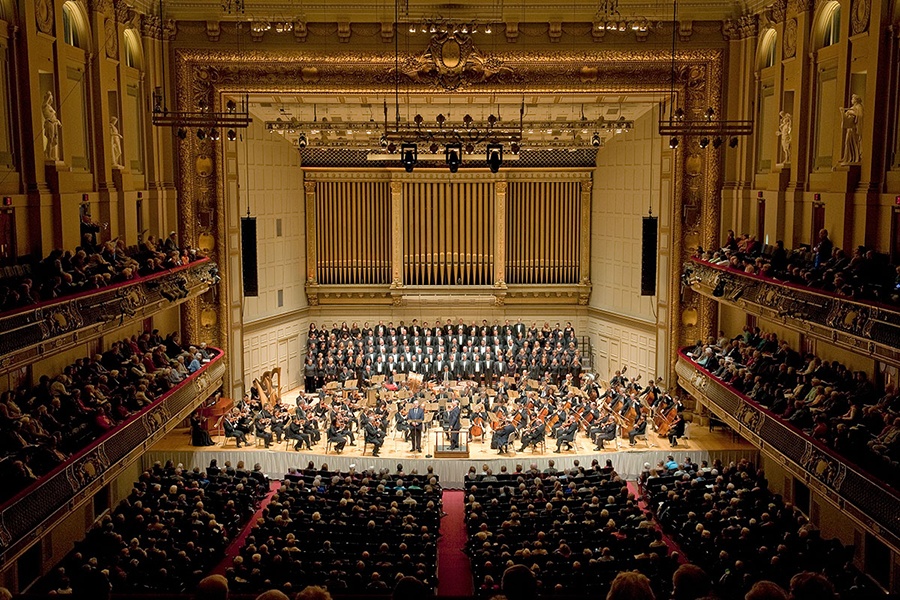 |
|
| |
发明了自己的测量设备后,萨宾发现礼堂的混响时间(声音消失的时间)约为5秒。所以,如果有人在说话,第一个词就会出现,而另外10个词也会出现,让人无法理解。萨宾用座椅坐垫作为他的标准吸收装置,小提琴和测量,发现一个礼堂的理想混响时间是1秒左右,他用地毯和窗帘纠正了福克的情况 |
|
|
|
| |
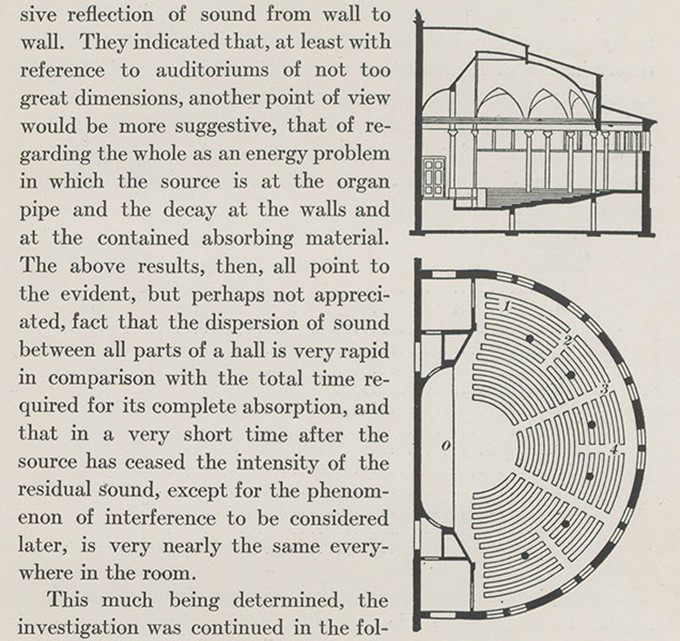 |
|
|
|
| |
哈佛佛格美术馆演讲室示意图,来自华莱士·萨宾,收集了关于声学的论文,1922年(琳达大厅图书馆) |
|
|
|
| |
Diagram of lecture
room at Fogg Art Museum, Harvard, from Wallace Sabine, Collected
Papers on Acoustics, 1922 (Linda Hall Library) |
|
|
|
| |
紧接着,萨宾被要求在波士顿音乐厅尝试一下,然后被设计。利用精心构造的壁龛和不寻常的矩形形状,Sabine设计了一个混响时间仅超过2秒的音乐厅,他认为这是理想的音乐。音乐厅(现在的波士顿交响音乐厅)于1900年完工,它的音响效果极佳;事实上,交响音乐厅仍然是世界上最好的收听场所之一(第一张和第五张图片)。最近,当这个舞台重新装修时,设计师们担心会影响到Sabine精美的声学设置,所以在重新装修时,他们使用了同样的木材、同样大小的木板,甚至是同样的手工锻造的钉子。在这方面,他们显然是成功的。 |
|
|
|
| |
Immediately
thereafter, Sabine was asked to have a go at the Boston Music
Hall, then being designed. Using carefully constructed wall
niches and an unusual rectangular shape, Sabine designed a music
hall with a reverb time of just over 2 seconds, which he deemed
ideal for music. The Music Hall (now Boston Symphony Hall) was
completed in 1900, and its acoustics were superb; indeed,
Symphony Hall still ranks as one of the top listening venues in
the world (first and fifth images). When the stage was recently
renovated, designers were so afraid of compromising Sabine’s
exquisite acoustical setting that they used the same wood, the
same size planks, and even the same hand-forged nails when they
redid the space. In this they were apparently successful. |
|
|
|
| |
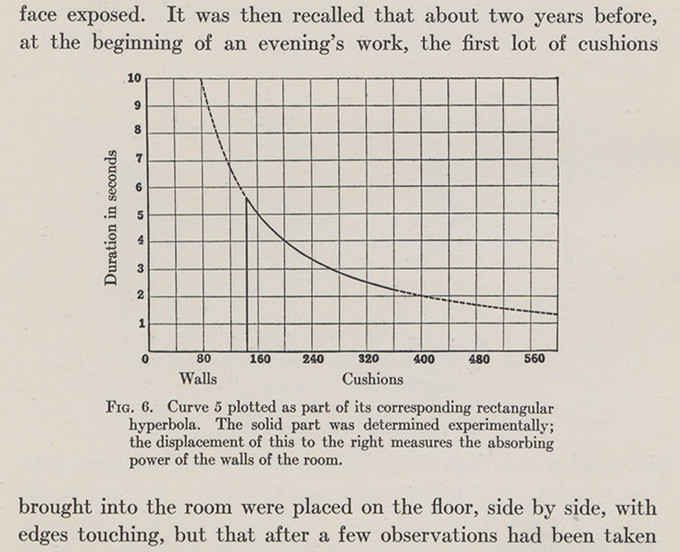 |
|
|
|
| |
图表显示混响时间的减少作为垫子添加到大厅,华莱士萨宾娜,收集声学论文,1922(琳达霍尔图书馆) |
|
|
|
| |
Graph showing the
decrease of reverb time as cushions are added to a hall, from
Wallace Sabine, Collected Papers on Acoustics, 1922 (Linda Hall
Library) |
|
|
|
| |
这是萨宾的荣誉,现代的吸声单位被称为萨宾,相当于一个打开的窗户一平方英尺的吸收能力(我不知道为什么要拼错他的名字来纪念他的荣誉)。萨宾的坐垫吸收了大约0.7
萨宾;人体吸收的能量约为4.7萨宾。 |
|
|
|
| |
In Sabine’s
honor, the modern unit of sound absorption is called the Sabin,
equivalent to the absorbing capacity of an open window one-foot
square (I am not sure why it is OK to honor someone by
misspelling his name). Sabine’s seat cushion had an absorption
of about 0.7 Sabins; that of the human body is about 4.7 Sabins. |
|
|
|
| |
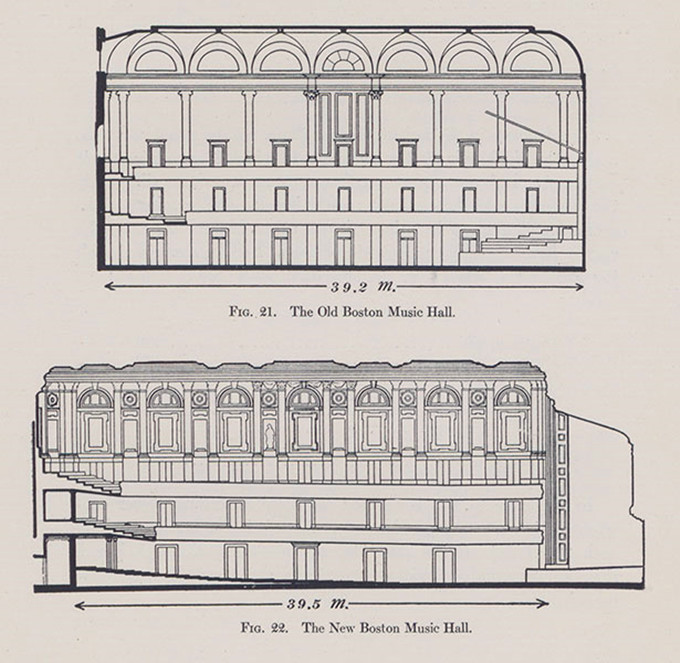 |
|
|
|
| |
新波士顿音乐厅,由华莱士·萨宾设计(上图),上面是旧音乐厅,来自华莱士·萨宾,收集声学论文,1922 (Linda
Hall图书馆) |
|
|
|
| |
The new Boston Music
Hall, designed by Wallace Sabine (bottom) with the old Music
Hall above, from Wallace Sabine, Collected Papers on Acoustics,
1922 (Linda Hall Library) |
|
|
|
| |
萨宾在1919年去世后,他在声学方面的各种论文在1922年以一卷的形式出版,题目是富有想象力的《声学论文集》(第五幅图)。我们了我们大部分的图像,包括图讲堂的福格艺术博物馆(第三图像),图表显示减少的混响时间的缓冲(第四形象),和一个图比较新的波士顿音乐厅和旧的(第六图片)。 |
|
|
|
| |
After
Sabine’s death in 1919, his various papers on acoustics were
published in a single volume in 1922, imaginatively titled
Collected Papers on Acoustics (fifth image). We drew on it for
most of our images, including a diagram of the lecture room at
the Fogg Art Museum (third image), a graph showing the decrease
of the reverb time with the addition of cushions (fourth image),
and a diagram comparing the new Boston Music Hall with the old
one (sixth image). |
|
|
|
| |
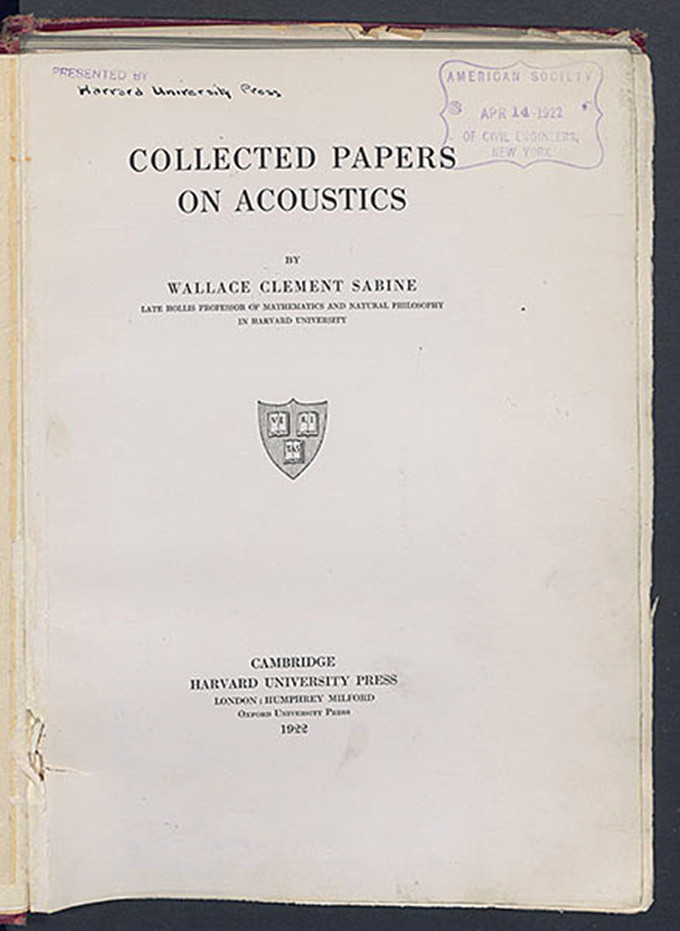 |
|
|
|
| |
《声学论文集》,华莱士·萨宾著,1922年(琳达·霍尔图书馆) |
|
|
|
| |
Title page, Wallace
Sabine, Collected Papers on Acoustics, 1922 (Linda Hall Library) |
|
|
|
| |
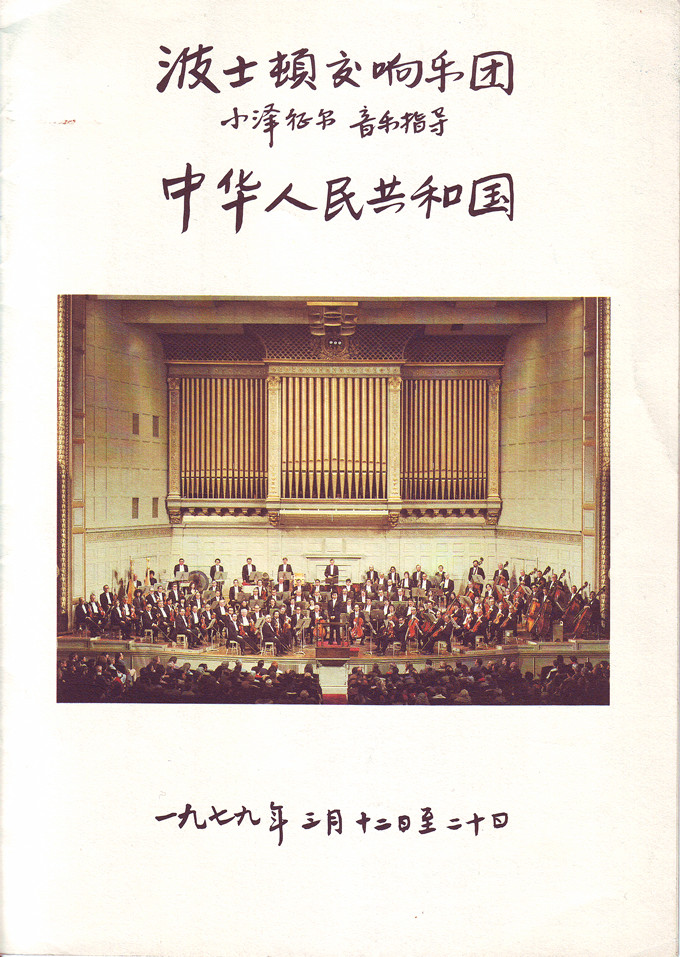 |
|
|
|
| |
这是本人收藏的一幅非常珍贵的节目单,波士顿交响乐团首次来华演出的节目单,背景就是波士顿交响音乐厅内部的图片
,这个节目单是一个朋友送给我的的——田润德 |
|
|
|
| |
|
|
|
|
| |
奥妙无穷的音乐厅 |
|
|
|
| |
以1962年落成的纽约林肯中心的艾弗瑞·费舍尔音乐厅(Avery Fisher
Hall)为例,它当年是作为最新声学科技成果的标本范例被设计出来的,该音乐厅的第一位声学设计师里奥·贝拉尼克是一位电气工程师,专攻信号处理和噪音衰减,曾经参与过世界上50多座音乐厅的设计。然而,费舍尔音乐厅的声音效果从第一天演出开始就让所有人都感觉别扭。14年后,它的内部结构被完全拆掉后重建。数十年来,林肯中心一直在对它的声学结构进行修修补补,但是一直都得不到满意的效果。结果,“饱受折磨”的林肯中心不得不于近日宣布:2009年费舍尔音乐厅将再次进行重建。
当年,贝拉尼克的继任者没有听从贝拉尼克的劝告,为容纳更多的观众席而擅自改变了音乐厅的容积和形状。但是,贝拉尼克也承认,即使没有这一点,费舍尔音乐厅也无法与卡内基音乐厅、波士顿交响音乐厅以及维也纳皇家音乐厅等世界超一流音乐厅相提并论。在这些经典的音乐殿堂里,音响的质感、空间感已臻完美,观众在这里听音乐会会感觉到被音乐围绕,甚至可以有“被音乐爱抚”的感觉。贝拉尼克在日记中写道:“那些年代久远而依然屹立的音乐厅都是音响效果最好的音乐厅,这正是它们为什么仍然能够屹立的原因。”
其实,费舍尔音乐厅的失败,并非全是科学上的原因,还有一种艺术上的错位。它源自一种更深层次的困惑:音乐厅和在其中被演奏的音乐之间的关系。伟大的音乐厅不仅决定着音乐听起来是什么样的,也同时能够决定音乐的创作和演绎本身。美国著名建筑评论家迈克尔·福西思在《音乐建筑:从17世纪到今天的建筑师、音乐家和听众》一书中指出,每一种形态的音乐都和某一种形态的空间紧密结合:格里高利圣咏有着整齐的速度和简单的对位,它和充满回响的大教堂以及石砌墙壁是分不开的;而同样的环境一定会把主题突出、转换和谐的贝多芬钢琴奏鸣曲搞得含混不清;巴洛克庭院中姿态高雅的音乐,到了古罗马露天圆形剧场就会消失殆尽;汉德尔的管风琴协奏曲之所以雅致、开朗、迷人,是因为作曲家很清楚这些作品将在伦敦茶园的圆型大厅中演奏,聆听音乐的听众同时也是悠闲漫步的茶客。
同样地,音乐厅也有与之相应的音乐。19世纪,音乐厅开始在公众文化生活中占据重要的地位,因此毫不奇怪,这个时期创作的音乐形式也多是特别适合在音乐厅中演奏的,比如交响乐、协奏曲等等。其它的音乐形式也曾经尝试在音乐厅中演绎,但是都感觉不太合拍,于是就慢慢退出了音乐厅的舞台。
同时,音乐厅也影响着到这里来的观众。如果一个音乐厅的建筑声学结构过于强调距离感和清晰的细节而打磨掉了混响,它就会让观众感觉到自己“不受欢迎”,因为对于观众来说,音乐好像存在于“另一个地方”,观众只能谨慎而谦恭地仔细聆听,而不可以密切和投入地与其接触与分享。这时候,音乐厅用音乐把公众聚拢在一起的职能就被破坏了。不幸的是,音乐审美在20世纪发生了变化。现代主义音乐追求的是冷酷的音响和近乎脆弱的明晰感,高清晰度恰恰成为了这一时期音乐厅声学结构设计的一个趋势。这是对传统听众的一个挑战。
这一时期也是音响效果成为一门科学的萌芽时期。第一位把音响效果学应用到音乐厅设计的专家是华莱士·克莱门特·萨宾,他是哈佛大学的物理学家,发现了声音回响的重要定律,并将其应用于波士顿交响音乐大厅的建筑设计上。这座1900年揭幕的音乐厅门前有一块牌匾,上书“世界上第一座按照声学原理建造的礼堂”。波士顿交响音乐大厅可以算是最后一座伟大的19世纪音乐厅,它并没有受到现代主义的影响,其目的只有一个:为管弦乐队服务。
从那以后,音响效果学拥有了自己的“生命”。1929年,美国音响效果协会成立,电子设备从单纯分析音响开始涉足重新制作音响的过程。这一变化最初在20世纪早期的大型电影院中体现了出来。最初美国的电影院大多采用的是欧洲歌剧院的模式和声学结构,还用管弦乐队来为无声电影伴奏。到了20年代后期,扬声器和放大器成为了新出现的有声电影的“关键因素”。1932年费城广播城音乐厅落成的时候,它的声学结构就是为音响放大器而设计的。那个时候音响效果专家担心的不是如何表达声音,而是如何控制声音,通过衰减或放大来进行声音控制成为了一种“工业”。在30、40年代,音乐厅经常设计成在观众席造成强烈的衰减、在舞台增加混响的效果。整个音乐厅就像是在模拟一只巨型扬声器。贝拉尼克形容1940年建成的克林汉音乐厅(Kleinhans
Music Hall)是“好比在一间铺着地毯的房间里听一个非常好的调频立体声电台”。20世纪的音乐厅经常标榜自己具有“高保真”效果。
这时,音乐厅的功能也发生了变化。卡内基音乐厅是按照管弦乐队的标准设计的,但是现在连摇滚乐队也可以在那里演出。实际上,20世纪后期建设音乐厅的标准就是:即使主要是为交响音乐设计的,也必须能够适应任何音乐形式的演出。这就是所谓的“给音乐厅调谐”。纽约爱乐音乐厅和费舍尔音乐厅都有可以调整的嵌板,纽约州立音乐剧院等甚至拥有电子控制的可变声场扬声器。
如今,高科技的手段已经可以“欺骗”人的耳朵了。许多发烧友用家庭影院就能营造出各种各样人工的声场环境,将来在音乐厅观看演出还能成为吸引人的体验吗?可以这么说,音乐厅再也不能塑造出独特的音乐和独特的听众了
|
|
|
|
| |
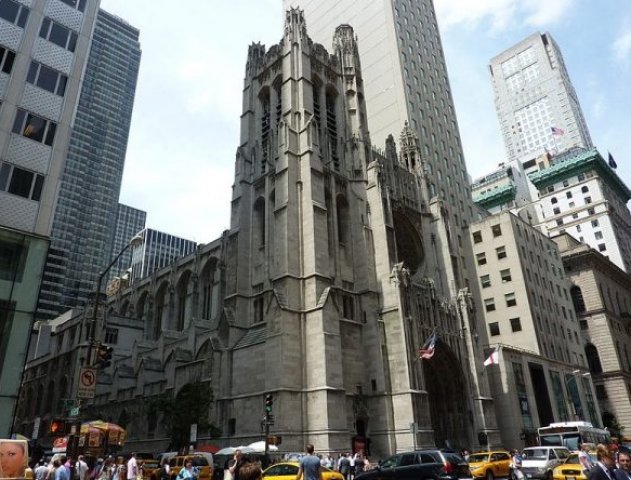 |
|
| |
美国纽约经常上演经典音乐会的圣托马斯大教堂 |
|
|
|
| |
The mysterious
concert hall
Take Avery Fisher Hall in Lincoln Center, New York, which was completed
in 1962 as an example. It was designed as a sample of the latest
achievements in acoustic technology. Leo Bellanik, the first acoustic
designer of the concert hall, is an electrical engineer specializing in
signal processing and noise attenuation. He has participated in the
design of more than 50 concert halls in the world. However, the sound
effect of Fisher Hall made everyone feel uncomfortable from the first
day of performance. Fourteen years later, its internal structure was
completely removed and rebuilt. For decades, the Lincoln Center has been
repairing its acoustic structure, but it has not achieved satisfactory
results. As a result, the "tortured" Lincoln Center had to announce
recently that the Fisher Hall would be rebuilt again in 2009.
In those years, Bellanik's successor did not listen to Bellanik's advice
and changed the volume and shape of the concert hall to accommodate more
audiences. However, Bellanik also admitted that even without this,
Fisher Hall could not compare with Carnegie Hall, Boston Symphony Hall,
Vienna Royal Concert Hall and other world-class concert halls. In these
classical music halls, the texture and sense of space of the sound have
reached perfection. The audience will feel surrounded by music when
listening to the concert here, and even feel "caressed by music".
Bellanik wrote in his diary: "Those concert halls that are still
standing for a long time are all concert halls with the best sound
effects, which is why they still stand."
In fact, the failure of Fisher Concert Hall was not all due to
scientific reasons, but also an artistic dislocation. It stems from a
deeper confusion: the relationship between the concert hall and the
music played in it. The great concert hall not only determines what
music sounds like, but also determines the creation and interpretation
of music itself. Michael Forsyth, a famous American architecture critic,
pointed out in his book "Music Architecture: Architects, Musicians and
Audiences from the 17th Century to Today" that every form of music is
closely combined with a certain form of space: Gregory Chant has a neat
speed and simple alignment, which is inseparable from the reverberant
cathedral and stone walls; The same environment will definitely make
Beethoven's piano sonata with prominent theme and harmonious
transformation ambiguous; The elegant music in the baroque courtyard
will disappear in the ancient Roman open-air amphitheater; The reason
why Handel's organ concerto is elegant, cheerful and charming is that
the composer is very clear that these works will be played in the round
hall of London Tea Garden, and the audience listening to the music is
also a leisurely tea drinker.
Similarly, concert halls also have corresponding music. In the 19th
century, concert halls began to occupy an important position in the
public cultural life, so it is not surprising that most of the music
forms created in this period are especially suitable for playing in
concert halls, such as symphonies, concertos, and so on. Other music
forms also tried to perform in the concert hall, but they didn't feel
very in tune, so they slowly withdrew from the stage of the concert
hall.
At the same time, the concert hall also affects the audience here. If
the architectural acoustic structure of a concert hall overemphasizes
the sense of distance and clear details to polish the reverberation, it
will make the audience feel that they are "unwelcome", because for the
audience, music seems to exist in "another place", and the audience can
only listen carefully and modestly, rather than contact and share with
them closely and devotedly. At this time, the concert hall's function of
gathering the public with music was destroyed. Unfortunately, musical
aesthetics changed in the 20th century. Modernist music pursues cold
sound and fragile clarity. High definition has become a trend in the
acoustic structure design of concert halls during this period. This is a
challenge to the traditional audience.
This period was also the embryonic period when sound effects became a
science. The first expert who applied sound effects to concert hall
design was Wallace Clement Sabin, a physicist at Harvard University. He
discovered the important law of sound reverberation and applied it to
the architectural design of Boston Symphony Hall. There is a plaque in
front of the concert hall opened in 1900, which reads "The first
auditorium built according to the principle of acoustics in the world".
Boston Symphony Hall can be regarded as the last great concert hall in
the 19th century. It is not affected by modernism, and its purpose is
only to serve the orchestra.
Since then, acoustics has had its own "life". In 1929, the American
Sound Effects Association was established, and electronic equipment
began to engage in the process of reproducing sound from the simple
analysis of sound. This change was first reflected in large cinemas in
the early 20th century. At first, American cinemas mostly adopted the
model and acoustic structure of European opera houses, and also used
orchestras to accompany silent films. By the late 1920s, speakers and
amplifiers had become the "key factors" of the emerging sound films.
When the Philadelphia Broadcasting City Concert Hall was completed in
1932, its acoustic structure was designed for sound amplifiers. At that
time, sound effect experts worried not about how to express sound, but
how to control sound. Sound control through attenuation or amplification
became an "industry". In the 1930s and 1940s, concert halls were often
designed to cause strong attenuation in the auditorium and increase
reverberation on the stage. The entire concert hall is like simulating a
giant loudspeaker. Bellanik described the Kleinhans Music Hall built in
1940 as "like listening to a very good FM stereo radio in a carpeted
room". Concert halls in the 20th century often touted their "high
fidelity" effects.
At this time, the functions of the concert hall also changed. Carnegie
Hall is designed according to the standards of orchestra, but now even
rock bands can perform there. In fact, the standard for the construction
of concert halls in the late 20th century is that even if they are
mainly designed for symphonic music, they must be able to adapt to any
form of music. This is called "tuning to the concert hall". New York
Philharmonic Concert Hall and Fisher Concert Hall both have adjustable
panels, and New York State Musical Theater even has electronically
controlled variable sound field speakers.
Nowadays, high-tech means can "cheat" people's ears. Many enthusiasts
can create a variety of artificial sound field environments with home
theaters. Will watching performances in concert halls be an attractive
experience in the future? It can be said that the concert hall can no
longer create unique music and unique audience |
|
|
|
| |
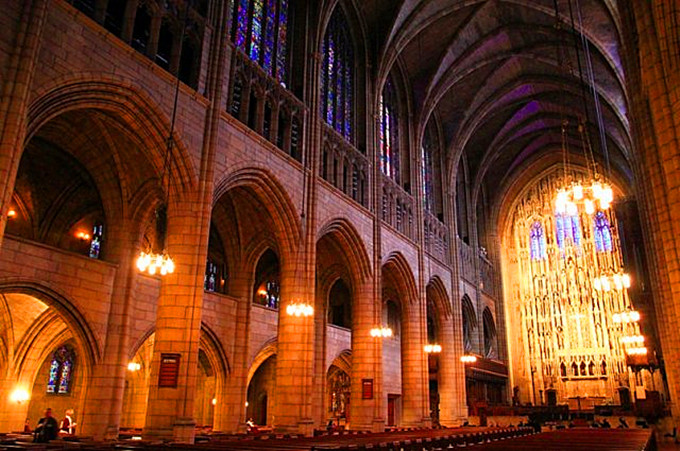 |
|
| |
美国纽约经常上演经典音乐会的圣托马斯大教堂内景,这里也曾经邀请了华莱士.萨宾(Wallace Sabine)进行音响的设计。 |
|
|
|
| |
|
|
|
|
| |
Today in the
history of music
On October 15, 1900, the Boston Symphony Orchestra moved into its
perfect symphony hall, designed by Wallace.Wallace Sabine (1868 --
1919).
Sabine,Wallace Clement Ware American physicist.Born June 13, 1868, in
Ridgewood, Ohio;He died January 10, 1919, in Cambridge,
Massachusetts.Sabin graduated from Ohio State University in 1886 and
went to Harvard University to pursue graduate studies.He eventually
taught at Harvard and became a professor of physics there in 1905.
In 1895, a new building was built at Harvard University with a very
decent classroom, except for the "small" defect that the lecture was too
loud to be heard.Sabin was brought in to solve this problem, and he not
only studied photographs of sound waves (which later D.C.S.Miller).Sabin
founded the science of architectural acoustics based on his own
research.Since then, what used to be a matter of chance has become a
matter of anticipation and calculation.The first building to follow
Sabin's principles was the Boston Concert Hall, which opened on October
15, 1900.The concert hall proved to be a great success.Sabin found that
he could translate the amount of sound absorbed in a room into the
number of large Windows in the room.Because the sound from the window to
the outside is the same as the sound absorbed by the curtain or
something.He measured the absorbability of many substances by comparing
the duration of echoes produced by them with a window defined by area as
a criterion for their absorbability.He found that the duration of the
echo -- so called reverberation time -- was a constant times the total
absorbability of the room, and that this constant was proportional to
the volume of the room.This is Sabin's law, and it forms the
architectural basis for designing sound-conscious rooms (such rooms
should have enough reverberation to keep the sound loud and full, but
not so much as to be hard to hear).
The Boston Symphony Hall is hosting Seiji Ozawa's final concert as music
director of the Boston Symphony Orchestra; 2. Anything is Possible --
The Boston Gay Men's ChoirRecorded live at bolton Music Hall on June 4,
2017. |
|
|
|
| |
|
|
|
|
| |
|
|
|
|
| |
《一切皆有可能》——波士顿男同性恋合唱团
2017年6月4日在波顿响音乐厅现场录制。
Anything Goes - Boston Gay Men's Chorus
Recorded live June 4, 2017 at Boston Symphony Hall. |
|
|
|
| |
|
|
|
|
| |
未得原作者编者授权严禁转载www.mt77.com任何内容 |
|
|
|
|
|
|
|
|
|
|
|
|
|
|

